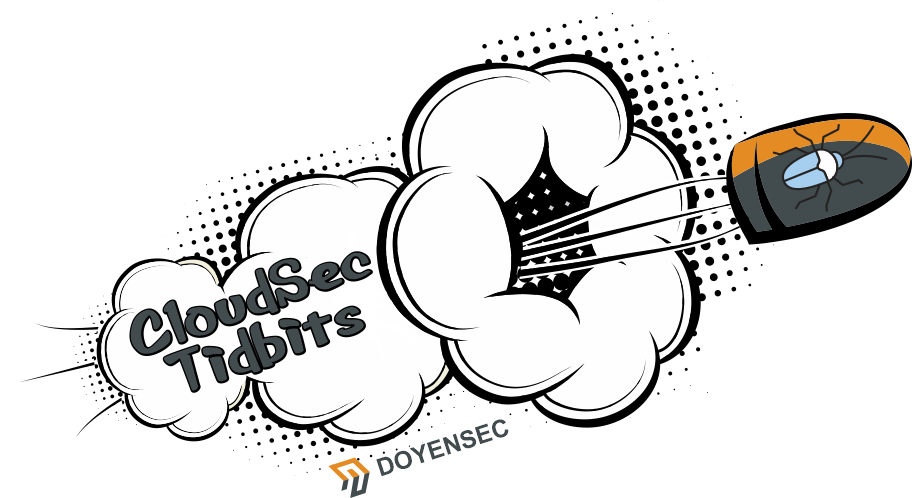The Danger of Falling to System Role in AWS SDK Client
18 Oct 2022 - Posted by Francesco Lacerenza, Mohamed Ouad

Introduction to the series
When it comes to Cloud Security, the first questions usually asked are:
- How is the infrastructure configured?
- Are there any public buckets?
- Are the VPC networks isolated?
- Does it use proper IAM settings?
As application security engineers, we think that there are more interesting and context-related questions such as:
- Which services provided by the cloud vendor are used?
- Among the used services, which ones are directly integrated within the web platform logic?
- How is the web application using such services?
- How are they combined to support the internal logic?
- Is the usage of services ever exposed or reachable by the end-user?
- Are there any unintended behaviors caused by cloud services within the web platform?
By answering these questions, we usually find bugs.
Today we introduce the “CloudSecTidbits” series to share ideas and knowledge about such questions.
CloudSec Tidbits is a blogpost series showcasing interesting bugs found by Doyensec during cloud security testing activities. We’ll focus on times when the cloud infrastructure is properly configured, but the web application fails to use the services correctly.
Each blogpost will discuss a specific vulnerability resulting from an insecure combination of web and cloud related technologies. Every article will include an Infrastructure as Code (IaC) laboratory that can be easily deployed to experiment with the described vulnerability.
Tidbit # 1 - The Danger of Falling to System Role in AWS SDK Client
Amazon Web Services offers a comprehensive SDK to interact with their cloud services.
Let’s first examine how credentials are configured. The AWS SDKs require users to pass access / secret keys in order to authenticate requests to AWS. Credentials can be specified in different ways, depending on the different use cases.
When the AWS client is initialized without directly providing the credential’s source, the AWS SDK acts using a clearly defined logic. The AWS SDK uses a different credential provider chain depending on the base language. The credential provider chain is an ordered list of sources where the AWS SDK will attempt to fetch credentials from. The first provider in the chain that returns credentials without an error will be used.
For example, the SDK for the Go language will use the following chain:
- 1) Environment variables
- 2) Shared credentials file
- 3) If the application uses ECS task definition or RunTask API operation, IAM role for tasks
- 4) If the application is running on an Amazon EC2 instance, IAM role for Amazon EC2
The code snippet below shows how the SDK retrieves the first valid credential provider:
Source: aws-sdk-go/aws/credentials/chain_provider.go
// Retrieve returns the credentials value or error if no provider returned
// without error.
//
// If a provider is found it will be cached and any calls to IsExpired()
// will return the expired state of the cached provider.
func (c *ChainProvider) Retrieve() (Value, error) {
var errs []error
for _, p := range c.Providers {
creds, err := p.Retrieve()
if err == nil {
c.curr = p
return creds, nil
}
errs = append(errs, err)
}
c.curr = nil
var err error
err = ErrNoValidProvidersFoundInChain
if c.VerboseErrors {
err = awserr.NewBatchError("NoCredentialProviders", "no valid providers in chain", errs)
}
return Value{}, err
}
After that first look at AWS SDK credentials, we can jump straight to the tidbit case.
Insecure AWS SDK Client Initialization In User Facing Functionalities - The Import From S3 Case
By testing several web platforms, we noticed that data import from external cloud services is an often recurring functionality. For example, some web platforms allow data import from third-party cloud storage services (e.g., AWS S3).
In this specific case, we will focus on a vulnerability identified in a web application that was using the AWS SDK for Go (v1) to implement an “Import Data From S3” functionality.
The user was able to make the platform fetch data from S3 by providing the following inputs:
-
S3 bucket name - Import from public source case;
OR
-
S3 bucket name + AWS Credentials - Import from private source case;
The code paths were handled by a function similar to the following structure:
func getObjectsList(session *Session, config *aws.Config, bucket_name string){
//initilize or re-initilize the S3 client
S3svc := s3.New(session, config)
objectsList, err := S3svc.ListObjectsV2(&s3.ListObjectsV2Input{
Bucket: bucket_name
})
return objectsList, err
}
func importData(req *http.Request) (success bool) {
srcConfig := &aws.Config{
Region: &config.Config.AWS.Region,
}
req.ParseForm()
bucket_name := req.Form.Get("bucket_name")
accessKey := req.Form.Get("access_key")
secretKey := req.Form.Get("secret_key")
region := req.Form.Get("region")
session_init, err := session.NewSession()
if err != nil {
return err, nil
}
aws_config = &aws.Config{
Region: region,
}
if len(accessKey) > 0 {
aws_config.Credentials = credentials.NewStaticCredentials(accessKey, secretKey, "")
} else {
aws_config.Credentials = credentials.AnonymousCredentials
}
objectList, err := getObjectsList(session_init, aws_config, bucket_name)
...
Despite using credentials.AnonymousCredentials when the user was not providing keys, the function had an interesting code path when ListObjectsV2 returned errors:
...
if err != nil {
if err, awsError := err.(awserr.Error); awsError {
aws_config.credentials = nil
getObjectsList(session_init, aws_config, bucket_name)
}
}
The error handling was setting aws_config.credentials = nil and trying again to list the objects in the bucket.
 Looking at
Looking at aws_config.credentials = nilUnder those circumstances, the credentials provider chain will be used and eventually the instance’s IAM role will be assumed. In our case, the automatically retrieved credentials had full access to internal S3 buckets.
The Simple Deduction
If internal S3 bucket names are exposed to the end-user by the platform (e.g., via network traffic), the user can use them as input for the “import from S3” functionality and inspect their content directly in the UI.
 Reading internal bucket names list extracted from Burp Suite history
Reading internal bucket names list extracted from Burp Suite historyIn fact, it is not uncommon to see internal bucket names in an application’s traffic as they are often used for internal data processing. In conclusion, providing internal bucket names resulted in them being fetched from the import functionality and added to the platform user’s data.
Different Client Credentials Initialization, Different Outcomes
AWS SDK clients require a Session object containing a Credential object for the initialization.
Described below are the three main ways to set the credentials needed by the client:
NewStaticCredentials
Within the credentials package, the NewStaticCredentials function returns a pointer to a new Credentials object wrapping static credentials.
Client initialization example with NewStaticCredentials:
package testing
import (
"time"
"github.com/aws/aws-sdk-go/aws"
"github.com/aws/aws-sdk-go/aws/credentials"
"github.com/aws/aws-sdk-go/aws/session"
)
var session = session.Must(session.NewSession(&aws.Config{
Credentials: credentials.NewStaticCredentials("AKIA….", "Secret", "Session"),
Region: aws.String("us-east-1"),
}))
Note: The credentials should not be hardcoded in code. Instead retrieve them from a secure vault at runtime.
{ nil | Unspecified } Credentials Object
If the session client is initialized without specifying a credential object, the credential provider chain will be used. Likewise, if the Credentials object is directly initialized to nil, the same behavior will occur.
Client initialization example without Credential object:
svc := s3.New(session.Must(session.NewSession(&aws.Config{
Region: aws.String("us-west-2"),
})))
Client initialization example with a nil valued Credential object:
svc := s3.New(session.Must(session.NewSession(&aws.Config{
Credentials: <nil_object>,
Region: aws.String("us-west-2"),
})))
Outcome: Both initialization methods will result in relying on the credential provider chain. Hence, the credentials (probably very privileged) retrieved from the chain will be used. As shown in the aforementioned “Import From S3” case study, not being aware of such behavior led to the exfiltration of internal buckets.
AnonymousCredentials
The right function for the right tasks ;)
AWS SDK for Go API Reference is here to help:
“AnonymousCredentials is an empty Credential object that can be used as dummy placeholder credentials for requests that do not need to be signed. This
AnonymousCredentialsobject can be used to configure a service not to sign requests when making service API calls. For example, when accessing public S3 buckets.”
svc := s3.New(session.Must(session.NewSession(&aws.Config{
Credentials: credentials.AnonymousCredentials,
})))
// Access public S3 buckets.
Basically, the AnonymousCredentials object is just an empty Credential object:
// source: https://github.com/aws/aws-sdk-go/blob/main/aws/credentials/credentials.go#L60
// AnonymousCredentials is an empty Credential object that can be used as
// dummy placeholder credentials for requests that do not need to be signed.
//
// These Credentials can be used to configure a service not to sign requests
// when making service API calls. For example, when accessing public
// s3 buckets.
//
// svc := s3.New(session.Must(session.NewSession(&aws.Config{
// Credentials: credentials.AnonymousCredentials,
// })))
// // Access public S3 buckets.
var AnonymousCredentials = NewStaticCredentials("", "", "")
For cloud security auditors
The vulnerability could be also found in the usage of other AWS services.
While auditing cloud-driven web platforms, look for every code path involving an AWS SDK client initialization.
For every code path answer the following questions:
-
Is the code path directly reachable from an end-user input point (feature or exposed API)?
e.g., AWS credentials taken from the user settings page within the platform or a user submits an AWS public resource to have it fetched/modified by the platform.
-
How are the client’s credentials initialized?
- credential provider chain - Look for the machine owned role in the chain
- Is there a fall-back condition? Look if the end-user can reach that code path with some inputs. If it is used by default, go on - Look for the role’s permissions
aws.Configstructure as input parameter - Look for the passed role’s permissions
- credential provider chain - Look for the machine owned role in the chain
-
Can users abuse the functionality to make the platform use the privileged credentials on their behalf and point to private resources within the AWS account?
e.g., “import from S3” functionality abused to import the infrastructure’s private buckets
For developers
Use the AnonymousAWSCredentials to configure the AWS SDK client when dealing with public resources.
From the official AWS documentations:
Using anonymous credentials will result in requests not being signed before sending them to the service. Any service that does not accept unsigned requests will return a service exception in this case.
In case of user provided credentials being used to integrate with other cloud services, the platform should avoid implementing fall-back to system role patterns. Ensure that the user provided credentials are correctly set to avoid ending up with aws.Config.Credentials = nil because it would result in the client using the credentials provider chain → System role.
Hands-On IaC Lab
As promised in the series’ introduction, we developed a Terraform (IaC) laboratory to deploy a vulnerable dummy application and play with the vulnerability: https://github.com/doyensec/cloudsec-tidbits/
Stay tuned for the next episode!

